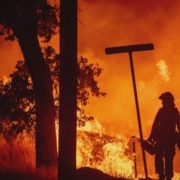California fires have again been making ground, less than a year after a record breaking fire burnt through parts of Southern California’s coast.
As of Tuesday morning, August 7, the Mendocino Complex Fire covered over 290,000 acres in Northern California’s Mendocino and Lake counties, making it the largest fire in California’s modern history.
Made up of two neighboring fires being the Ranch Fire and River Fire which erupted less than two weeks ago, it has burned through an area nearly the size of Los Angeles, and almost 10 times the size of San Francisco.
It overtook last year’s Thomas Fire which devastated parts of the Santa Barbara and Ventura counties, leaving over 282,000 acres burned.
So far, 143 structures have been destroyed by the flames including 75 residences, and 68 other structures. Thousands of people have been evacuated, but no deaths have yet been reported.
As of Tuesday morning, the Mendocino Complex Fire was only 34 percent contained. Officials initially hoped to have the fires out by mid-August, but on Tuesday said that containment looked more likely to happen early September.
According to AccuWeather, heat and poor relatively humidity will continue to pose a challenge for firefighters.
“Firefighters continue to battle the River and Ranch fires. Crews worked throughout the night to reinforce containment lines while the fire behavior remained extreme,” the California Department of Forestry and Fire Protection (Cal Fire) said Tuesday.
Cal Fire added, “Weather conditions will continue to challenge firefighters as hot, dry and windy conditions persist.”
Stronger California fires
High temperatures and prolonged drought have been fueling bigger and stronger fires in the state. Nine of the top 20 largest California wildfires have occured within the last decade, according to Cal Fire data.
In Northern California’s Shasta County, the still burning Carr Fire moved through over 167,000 acres as of Tuesday, becoming the 12th largest recorded in California.
Around 1,600 structures have been destroyed and seven deaths have been recorded — the seventh being a Pacific Gas & Electric worker who died on Saturday, August 4 while doing restoration work.
The Trump administration in response, announced a disaster declaration that makes federal funds available to Shasta County residents.
Philippine Consul General Henry Bensurto in San Francisco reported a week after it started that no Filipinos had been affected by the fire which threatens the nearby city of Redding, home to a small community of about 227 Filipinos.
Entering its third week, the Ferguson Fire killed two people, injured 11 others, and prompted indefinite closures at parts of Yosemite National Park and Yosemite Valley.
In Southern California, the Holy Fire broke out in Orange County on Monday afternoon, August 6 and quickly burned through 4,000 acres in the Cleveland National Forest. It was two-percent contained as of Tuesday morning.
President Donald Trump gave his thoughts on Twitter, pointing to California’s environmental laws and management of water resources as being a culprit behind the fires.
“California wildfires are being magnified and made so much worse by the bad environmental laws which aren’t allowing massive amount of readily available water to be properly utilized. It is being diverted into the Pacific Ocean. Must also tree clear to stop fire spreading!” Trump tweeted without giving further detail on Sunday, August 5.
Environmental advocates, including some politicians, on the other hand have put weight on climate change as being a leading factor.
California Governor Jerry Brown said last week that the fires were evidence of climate change happening “in real time.”
“[The] predictions that I see, the more serious predictions of warming and fires to occur later in the century, 2040 or 2050, they’re now occurring in real time,” said Brown at a news conference in Sacramento last Wednesday, August 1.
“You can expect that — unfortunately — to continue intensifying in California and throughout the Southwest. We are part of that process,” added Brown.
A 2016 study in the Proceedings of the National Academy of Sciences cited human-caused climate change as a key driver for forest fire, saying it doubled the amount fires along western U.S. forests since 1984. (Rae Ann Varona/AJPress)







